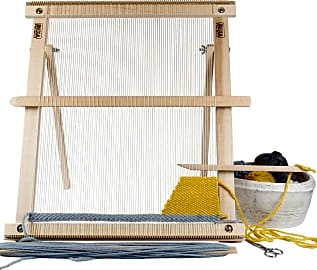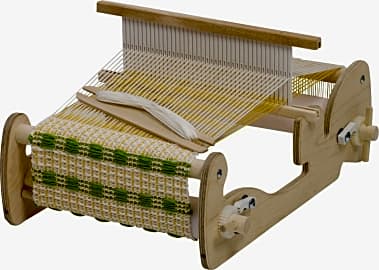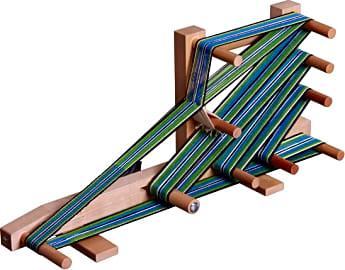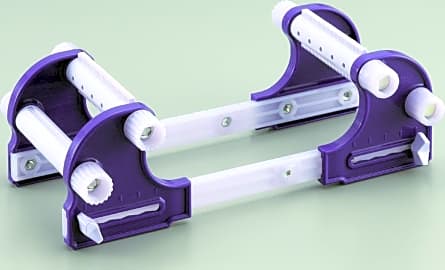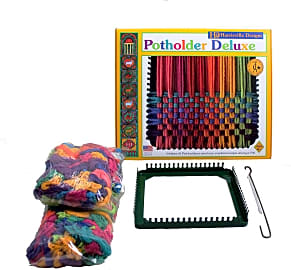The 10 Best Looms

This wiki has been updated 41 times since it was first published in June of 2016. In today's technological world, it's easy to forget the simple pleasure of using one's hands to create useful and lasting items. The looms on this list are not only capable of making all sorts of things, including hats, belts, scarves, pot holders, and tapestries, but they also provide a marvelous way to unwind from the stresses and strains of modern life. When users buy our independently chosen editorial recommendations, we may earn commissions to help fund the Wiki.
Editor's Notes
February 14, 2020:
On top of being able to make creations you are proud of, loom knitting also has a host of health benefits, including calming the mind much the same way meditation does. For children, it helps build hand-eye coordination, problem-solving skills, and confidence. They're also handy if you're looking for an alternative to needle knitting, which can be hard on the hands if you have mobility issues.
Many of the looms on this list, such as the Ashford Inklette, Beka Weaving Frame With Stand, and even the higher-end Ashford Rigid Heddle are appropriate for many skill levels, so a beginner could pick one up and grow with it for some time. We also wanted to supply more economical choices for children who may or may not take to their new hobby. Units like the Darice Knitting Set, The Original Rainbow, and Melissa & Doug Multi-Craft are ideal for piquing a youngster's interest without breaking the bank.
Because the Clover Beading was the sole beadwork option on this list before our latest update, we added the adjustable Missouri River Deluxe in place of the Purl & Loop Stash Blaster to add a second selection with more versatility. The Purl & Loop model is still a great choice if you find yourself burdened with extra scraps, however, we felt the Missouri loom offers more creative range.
Special Honors
Glimakra Victoria Coming from Swedish company Glimakra, the Victoria follows a long line of proven construction techniques. It has a 27-inch weaving width, is lightweight, compact, and can be transported without losing your warp. The hand-operated levers make it accessible to those with mobility impairments, and a floor stand is also available. glimakrausa.com
Louet Jane Designed by a weaver for weavers, the Jane is made of lacquered beech and offers simple, yet innovative, features. That includes a handle to carry it and a locking mechanism, as well as toggles that operate smoothly and always stay in their engaged position. The loom folds with a warp on and can be secured so it doesn't open during transport. louet.com
Why Should I Try Weaving?
The repetitive movements and focus required for textile crafting produces a soothing effect akin to practicing yoga or meditation.
For thousands of years, dating back to the Neolithic era, most households had a loom to produce their own cloth for their individual family needs. While it is no longer necessary or practical to weave your own textiles, there are still a lot of good reasons to have a loom. These days a few exceptionally skilled weavers can actually make money creating goods on a loom, but for most people the benefits of weaving will be of a more personal nature.
Adopting a new crafting hobby has been found to have numerous health and social benefits. The repetitive movements and focus required for textile crafting produces a soothing effect akin to practicing yoga or meditation. The creativity and problem solving involved in making your own fabrics is also a proven way to protect neural pathways, and head off mild cognitive impairment. Children can also benefit greatly as they develop greater hand-eye coordination and fine motor skills, while empowering their imaginations. Crafting groups have become a popular excuse for a social gathering, as well, as seen by the rise of knit-ins and "stitch 'n bitch" parties. In addition, these gatherings are a great opportunity for teaching and learning new skills, as well as developing deeper friendships.
If you're tired of impersonal gift-cards, and you're constantly searching for a way to make gift-giving more special, a loom opens up a wide array of possibilities. When you are familiar with a friend or family-member's home decor, you can create fun accents like pillow covers, small rugs, placemats, or napkins. Or you can treat someone to a hand-made scarf or a unique bag. For someone accessorizing or decorating their own home on a budget, having a loom allows you to change up your look without having to spend a lot of money.
How To Choose The Right Loom
If you're like most people in the market for a loom, you are probably interested in either trying a new hobby or looking for a different kind of gift for a creative child. While you might be inclined to simply choose the largest or the cheapest loom to get you started, consider how it will be used before making your choice. Do you envision yourself working on projects while watching television with the family? Some smaller looms are designed to be used right in your lap. Children will appreciate complete kits that come with pattern ideas and yarn included.
You can find smaller, traditional wooden looms that weigh less than 10 pounds, or you might want to consider knitting looms for maximum portability.
The type of person who likes to leave projects out while working on them might want to consider investing in a higher quality wooden loom, even if it's for a beginner. These models have an old fashioned styling that, when not in use, can add a vintage touch to your decor. If you choose a larger loom, you can buy a stand for it so as not to take up valuable table space. In fact, some crafters prefer to work with a loom on a stand instead of at a table. Wooden looms can be personalized by staining the wood to match other furniture, or even decorated with a wood burning kit.
The more portable looms are ideal if you want to start or join a neighborhood crafting group. You can find smaller, traditional wooden looms that weigh less than 10 pounds, or you might want to consider knitting looms for maximum portability. Knitting looms are often plastic and can easily slip into a large purse or carry-all. These specialty looms allow you to easily knit projects without knitting needles.
A Brief History Of The Loom
The origins of the first weaving loom are unknown; woven textiles have been a part of human culture for many thousands of years. This ancient art was most certainly present during the Neolithic era, when humans began farming. Researchers have even found a scrap of textile that dates back over 5,000 years. In addition, multiple references to looms and weaving can be found in the Old Testament of the Bible. By biblical times, most major civilizations used looms to create cloth. The Egyptians preferred flax, while others favored wool, and it was around this time that the Chinese began weaving silk from silkworms.
This technology spread throughout Medieval Europe, during which time the craft of weaving expanded.
The earliest looms were large, unwieldy machines that required two or three people to operate them. Most weaving was done in the home, often by children or slaves. The first major improvement to the loom came during the Islamic golden age, around the 8th century C.E. Demand for fabric was high because the faithful were required to cover themselves from neck to ankle. As necessity is often the mother of invention, a foot pedal was added to operate the heddle, freeing up the weaver's hands to pass the shuttle. This technology spread throughout Medieval Europe, during which time the craft of weaving expanded. Skilled artisans formed guilds, and looms began to move out of the home and into specialized shops.
In 1733, an Englishman named John Kay created the flying shuttle. This innovation not only made weaving significantly faster, but also allowed for the creation of wider pieces. A few decades later, with the advent of the industrial age, the first textile factory was built. Steam powered engines allowed for even faster production. Even intricate woven designs became fully mechanized with the invention of the Jacquard loom in France, in 1803. Named after Joseph-Marie Jacquard, this machine used a series of punch cards to create more complicated patterns that, until then, still required the expertise of skilled weavers.


